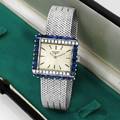$7,110
Historic "Bonaventure Hatchet," Penobscot, the spiked cast iron head dates to the late 17th century, the wood handle with pyro-engraved track marks and hide bindings to the 19th century, handle lg. 17, blade lg. 6 3/4 in. Provenance: Dr. Frank T. Siebert Collection. Note: The present Penobscot example was bequeathed to me by Penobscot Lewis Lolar at the time of his death on March 17, 1935. Lolar was a direct descendant of the famous Penoscot war-chief Loron (alias Saaguarum) during the intercolonial wars, and the hatchet had been handed down in the family. It is made of cast iron, and is considerably patinated and corroded by time. The hatchet head measures 6-3/4 x 2-7/16 x 7/16 inches and is illustrated in the accompanying photograph. The haft or handle is, of course, modern, having been replaced in the nineteenth century. This weapon is light enough to be thrown efficiently, and strong and sharp enough to render a severe cutting blow. The spike served another purpose. If wielded forcefully in hand-to-hand combat, the spike could be thrust between the ribs of an opponent, readily puncture the pleura, and cause a lung collapse or pneumothorax. This would produce a form of shock in the victim and render him hors de combat. This hatchet of French manufacture was designed by the Simon-Pierre Denys de Bonaventure (1659-1711), a French naval officer. He had them cast in Paris in 1695 and had about 250 of them made. Bonaventure brought them to Acadia in the Envieux in the spri Read more…

Auctioneer:
Skinner
Date:
2011-09-24










